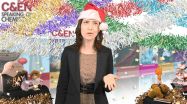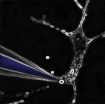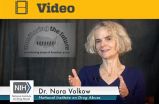A lot or a little
Wolves discriminate quantities better than dogs
2014-12-16
(Press-News.org) People and animals have been shown to discriminate between quantities. Lions, chimpanzees and hyenas, for example, will only approach a group of attackers if their own group outnumbers that of the intruders. These animals use numerical information to make decisions about their social life.
Testing numerical competence
In 2012 Friederike Range and Zsofia Virányi from the Messerli Research Institute at the University of Veterinary Medicine Vienna showed that wolves are capable of discriminating between different food quantities. In their present study, they asked whether dogs also possess this skill or if this form of numerical competence was lost through domestication.
For the study, Range and her colleagues from the Department of Comparative Cognitive Research tested 13 crossbreed dogs raised at the Wolf Science Center in Ernstbrunn. The animals are living there together in different packs. The researchers tested the dogs for their quantity discrimination skills by presenting pieces of cheese. Those pieces were sequentially placed into two opaque tubes - one on the left and another on the right side. Eventually, the dogs had to decide which tube contained more cheese pieces than the other. By pressing the correct buzzer, the dogs were rewarded with cheese from the respective tube. Furthermore, the dogs did not see the person placing the cheese into the tubes, which excludes the human influence as a factor.
"We deliberately performed the test in such a way that the dogs never saw the full quantity of food at once. We showed them the pieces sequentially. This allows us to exclude the possibility that the dogs were basing their decisions on simple factors such as overall volume. The dogs had to mentally represent the number of pieces in a tube," explains first author Range.
Dogs performed worse than wolves
Range and her colleagues compared the results of the wolf test with those from the dog test. The comparison showed that dogs were unable to discriminate between difficult comparisons such as two pieces of food versus three or three pieces versus four. The wolves, in comparison, fared much better. "Dogs are better able to discriminate the quantities of food when they can see them in their entirety," says Range. "But this requires no mental representation."
Numerical competence lost with domestication
Range and her team are now investigating why the dogs performed so poorly in these tests. Is it because they have difficulties processing numerical information or is it their lacking ability for mental representation? It is possible that one of these skills was lost over the course of domestication. Human beings could be to blame. "Compared to wolves, domestic dogs no longer have to search for food on their own. They have a secure place to sleep and even mating decisions are made by people. Dogs are thus excluded from natural selection," Range explains.
INFORMATION:
Service:
The article „Difference in quantity discrimination in dogs and wolves", by Friederike Range, Julia Jenikejew, Isabelle Schröder and Zsófia Virányi was published in the journal Frontiers in Psychology. doi: 10.3389/fpsyg.2014.01299 http://journal.frontiersin.org/Journal/10.3389/fpsyg.2014.01299/abstract
About the University of Veterinary Medicine, Vienna
The University of Veterinary Medicine, Vienna in Austria is one of the leading academic and research institutions in the field of Veterinary Sciences in Europe. About 1,300 employees and 2,300 students work on the campus in the north of Vienna which also houses five university clinics and various research sites. Outside of Vienna the university operates Teaching and Research Farms. http://www.vetmeduni.ac.at
Scientific Contact:
Friederike Range, PhD
Messerli Research Institute, Unit of Comparative Cognition
University of Veterinary Medicine Vienna (Vetmeduni Vienna)
T +43 664 60257-6252
friederike.range@vetmeduni.ac.at
Released by:
Susanna Kautschitsch
Science Communication / Public Relations
University of Veterinary Medicine Vienna (Vetmeduni Vienna)
T +43 1 25077-1153
susanna.kautschitsch@vetmeduni.ac.at
[Attachments] See images for this press release:

ELSE PRESS RELEASES FROM THIS DATE:
2014-12-16
Stimulants use such as cocaine and amphetamine is associated with a nearly two-fold greater likelihood of suicidal behaviour amongst people who inject drugs, say researchers at the University of Montreal and the CHUM Research Centre. Drug addiction had already been identified as a major risk factor for suicide, and it is in fact the cause of ten percent of deaths among drug users. The data from this groundbreaking study could help develop and evaluate more appropriate suicide prevention efforts in this highly vulnerable population.
The researchers were able to explore ...
2014-12-16
GPs should consider a more overt discussion with patients when referring them for further investigation of symptoms which may indicate cancer, according to a paper published in the British Journal of General Practice.
In an NIHR-funded study, researchers from the Universities of Bristol, Cambridge, Durham and Exeter conducted interviews with patients being referred for possible lung and colorectal cancer.
They found that patients were rarely involved in the decision to be referred for investigation and that reasons for referral tended to be couched in non-specific ...
2014-12-16
WASHINGTON, Dec. 16, 2014 -- It's been a holiday decoration staple for decades, and it turns out that silver stuff hanging from your tree has quite a storied past. Tinsel has been made out of everything from real silver, to lead to other dangerously flammable materials. This week's Speaking of Chemistry decks your halls with the history of tinsel. Check it out at http://youtu.be/fql3aCuu1l0.
INFORMATION:
Speaking of Chemistry is a production of Chemical & Engineering News, a weekly magazine of the American Chemical Society. The program features fascinating, weird and ...
2014-12-16
University of Guelph researchers hope their new discovery will help combat a disease killing honeybee populations around the world.
The researchers have found a toxin released by the pathogen that causes American foulbrood disease -- Paenibacillus larvae (P. larvae) -- and developed a lead-based inhibitor against it.
The study was published in the December issue of the Journal of Biological Chemistry.
The finding provides much-needed insight into how the infection occurs, said Rod Merrill, a professor in Guelph's Department of Molecular and Cellular Biology and a ...
2014-12-16
PROVIDENCE, R.I. [Brown University] -- Newly published research provides the first demonstration of how a genetic mutation associated with a common form of albinism leads to the lack of melanin pigments that characterizes the condition.
About 1 in 40,000 people worldwide have type 2 oculocutaneous albinism, which has symptoms of unsually light hair and skin coloration, vision problems, and reduced protection from sunlight-related skin or eye cancers. Scientists have known for about 20 years that the condition is linked to mutations in the gene that produces the OCA2 protein, ...
2014-12-16
JACKSONVILLE, Fla. -- It may not be necessary for experienced gastroenterologists to send polyps they remove from a patient's colon to a pathologist for examination, according to a large study conducted by physician researchers at the Jacksonville campus of Mayo Clinic.
Their 522-patient study, published in the December issue of Gastrointestinal Endoscopy, found that physicians correctly evaluated whether a polyp was precancerous or benign using high-definition optical lenses during a colonoscopy. Their assessment was 96 or 97 percent accurate -- depending on which of ...
2014-12-16
There are consequences of the successful efforts worldwide to save beavers from extinction. Along with the strong increase in their population over the past 100 years, these furry aquatic rodents have built many more ponds, establishing vital aquatic habitat. In doing so, however, they have created conditions for climate changing methane gas to be generated in this shallow standing water, and the gas is subsequently released into the atmosphere. In fact, 200 times more of this greenhouse gas is released from beaver ponds today than was the case around the year 1900, estimates ...
2014-12-16
Use of cigarettes, alcohol, and abuse of prescription pain relievers among teens has declined since 2013 while marijuana use rates were stable, according to the 2014 Monitoring the Future (MTF) survey, released today by the National Institute on Drug Abuse (NIDA). However, use of e-cigarettes, measured in the report for the first time, is high.
These 2014 results are part of an overall two-decade trend among the nation's youth. The MTF survey measures drug use and attitudes among eighth, 10th, and 12th graders, is funded by NIDA, and is conducted by researchers at the ...
2014-12-16
EAST LANSING, Mich. --- Domestic violence can affect children even before they're born, indicates new research by Michigan State University scientists.
The study is the first to link abuse of pregnant women with emotional and behavioral trauma symptoms in their children within the first year of life. Symptoms include nightmares, startling easily, being bothered by loud noises and bright lights, avoiding physical contact and having trouble experiencing enjoyment.
"For clinicians and mothers, knowing that the prenatal experience of their domestic violence can directly ...
2014-12-16
New Rochelle, NY, December 16, 2014--Veterans of the U.S. armed forces who have received a diagnosis consistent with transgender status are more likely to have serious suicidal thoughts and plans and to attempt suicide. A new study shows that this group has a higher risk of suicide death than the general population of veterans, as described in an article in LGBT Health, a peer-reviewed journal from Mary Ann Liebert, Inc., publishers. The article is available free on the LGBT Health website until January 16, 2015.
Based on data gathered from the VA National Patient Care ...
LAST 30 PRESS RELEASES:
[Press-News.org] A lot or a little
Wolves discriminate quantities better than dogs





